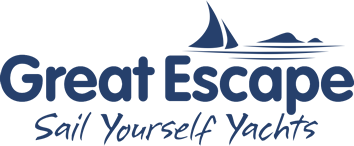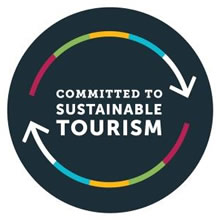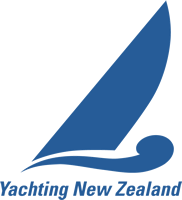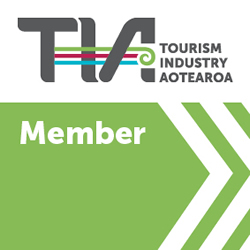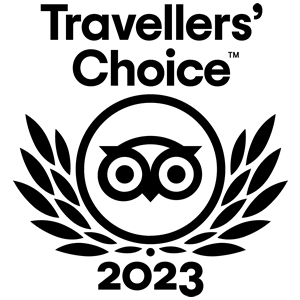Those dreaming of their first offshore might find this article I wrote for Boating NZ useful. It was written not long after our first passage as a family and details the good and the not so good! It was published in November 2007, a few things have changed since then, so treat the information as a guideline, not a manual! Enjoy, Cheers Julie.
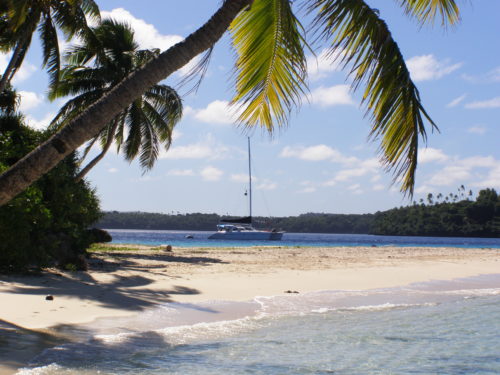 “Before the tropical sunshine befuddles my brain and tricks my memory, I want to share with you the tale of our family’s first offshore passage…
“Before the tropical sunshine befuddles my brain and tricks my memory, I want to share with you the tale of our family’s first offshore passage…
This is the stuff that never makes it into the glossy travel brochures – the eternal preparation; “to do” lists and mammoth shopping trips before you leave, followed by the challenges of the actual voyage: discomfort, sleep deprivation, seasickness, mental challenges and basic tasks you struggle with on a constantly moving boat.
But, on arrival at your first foreign port, the elation tastes as good as the coconuts and it’s easy to understand the lure of a tropical paradise for families new to cruising – and easy to forget the challenges in getting there.
Preparation
Before departure, planning and preparation absorbed all our time. We’d been dreaming of this voyage for a decade, but our final preparation took 12 months, focusing on boat, expertise and supplies.
We ended up with a notebook to which we would add “to do” or “to buy” items. It was fluorescent red so we could find it: at home, in the car, on the boat, whenever we happened to be when a new item had to be noted. The list was infinite, so we started categorising items as A, B, or C; essential, nice to have, and luxuries. As the departure date loomed, the B’s and C’s dropped off the list. Then we edited the A’s, to that we could afford, and that time permitted. Had we attempted to complete all the jobs on the list, we would never have left.
Our list of essential safety items basically reflected the Yachting New Zealand Category One requirements. It began when we were building the boat; for example, an aft locker for the life-raft while underway. It had to be secure so the raft wouldn’t get washed over, and wouldn’t obstruct access or sailing, but which we could reach whether or not the boat was the right way up. We had built emergency escape hatches into the hulls too.
Then came the equipment we would need to cope with emergencies: flares, a grab bag and handheld VHF radio. Finally when the boat was launched a qualified YNZ inspector gave it a last check for seaworthiness according to Category One.
In preparing the boat the safety regulations had given us a good place to start but we had to add what we might need beyond the YNZ requirements. We would be sailing with two young children; that meant additional medical supplies, the fitting of low-level safety nets and barriers, placement of handholds and jack-lines and modification of grab bag contents.
We also needed procedural guidelines, – these included mandatory lifejackets for children beyond the cockpit, no going forward without safely harnesses. The adults agreed to wear safety harnesses on single-handed watches, beyond the cockpit and at night. We established a watch system and key responsibilities.
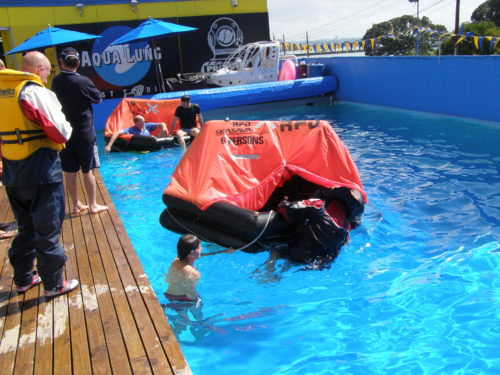 In developing our expertise, we worked on formal and informal learning. We both attended the Northern Region Coastguard Coastal Skippers course. We’d been sailing for years and had done off-shore deliveries on other people’s boats, but the course was an excellent refresher and taught us stuff we should have known years ago. We also did the off-shore medic course facilitated through Yachting NZ. It was an introduction to medical disasters and possible interventions. Being a specialist yachting course, it recognised that we were not just stemming the blood flow whilst waiting for an ambulance, we might have to cope with an injury or illness without outside assistance for several days. It was especially reassuring to know we could access medical expertise via SSB if required.
In developing our expertise, we worked on formal and informal learning. We both attended the Northern Region Coastguard Coastal Skippers course. We’d been sailing for years and had done off-shore deliveries on other people’s boats, but the course was an excellent refresher and taught us stuff we should have known years ago. We also did the off-shore medic course facilitated through Yachting NZ. It was an introduction to medical disasters and possible interventions. Being a specialist yachting course, it recognised that we were not just stemming the blood flow whilst waiting for an ambulance, we might have to cope with an injury or illness without outside assistance for several days. It was especially reassuring to know we could access medical expertise via SSB if required.
And we attended a life-raft demonstration hosted by the Island Cruising Association. As we struggled to climb into the raft, in the sheltered swimming pool, wearing full wet weather gear, we could only imagine the difficulty of attempting it in foul conditions. We also got to see the contents in the life raft: we smiled at the patch kit which had to be applied to a dry surface and, after sampling the unappetising milk protein bars and marvelling at the tiny sachets of emergency water we added other long-life food items to our grab bag.
Shakedown passage
Our informal preparation included a coastal cruise around the North Island, including a three-day passage down the West Coast; from Spirit’s Bay at the top of the North Island to Squally Cove at the top of the South Island. This was a great trip, we tested the boat, it’s systems and visited some beautiful cruising grounds. Most importantly, it gave the children confidence and experience of life onboard.
Beyond basic safety, we considered cruising comfort and the logistics of stowing all the paraphernalia for extended liveaboard cruising. This includes galley gear, ships stores, children’s clothes, toys, puzzles, squabs for the cockpit, cockpit shade, engine spares, sail repair kits, fishing gear, water toys and happy hour delights. It was like throwing money into an endless bucket of requirements.
Early on we decided to take an extra adult for the passage. This was a good decision. It ensured we weren’t too tired during the passage and when required one parent could focus on the children. It also gave us a safety margin if either of us got injured or the conditions got bad.
We joined the Island Cruising Association (ICA) rally to Tonga, despite concerns that an organised group might not work for us but it turned out to be a worthwhile experience. Prior to departure, we attended ICA social functions and briefings, and the association arranged early customs clearance from New Zealand and for customs and immigration to meet us on arrival at Pangaimotu, which saved us the hassle of having to go into Nuku’alofa to deal with officials. The biggest benefit has been the wonderful friends we have met. I had assumed most rally participants would be novices, but many had completed thousands of miles and happily shared their expertise. There were always parties on arrival and we made good friends with whom we met up with throughout the season.
To Tonga
Our passage from New Zealand to Tonga took 6 ¼ days, about 151 hours. It wasn’t a bad trip, but we had a smorgasbord of conditions. We left Opua in lovely sunshine, calm seas and no wind. The middle part of the trip brought more than forty knots and five-metre seas but we finished with a delightful sail on the last day, with land in sight and just the right amount of wind from the right quarter.
Overall we averaged seven knots for the passage, a safe comfortable speed, but less than we would have liked.
The distance from Opua to Tongatapu landfall is approximately 1050 kms. The best time to complete this passage is from mid-April to mid-May, when it hasn’t got too cold for the first part of the trip and the cyclone season is over.
The theory is to wait for the back of a south-westerly in New Zealand, leave in light airs, and make some easting aiming for the general direction of the Kermadec Islands, while in the lower latitudes to make the most of the south-east trades. When you’re in the trades make some easting to provide an easy reach to landfall.
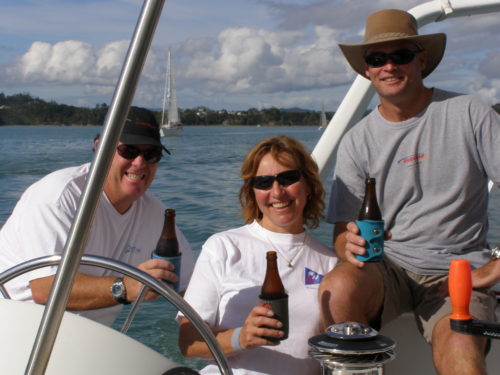 Casting off
Casting off
We started at 10 am, Saturday 5th May with the ICA rally. Because it is a rally, not a race, starting at this time is skipper’s discretion. Three of the fleet had already elected to depart early but the remaining sixteen boats lined up at the scheduled time. There was no wind although some of us hoisted sails for appearance. Opua Cruising Club gave the fleet a great send-off and with cheers and hooting from friends and family.
A few of the fleet headed west for a planned stopover at Minerva reef. We stuck to the recommended route and started heading east. With no wind, we motored conservatively at about five knots for the first two days.
We were wishing for wind and the chance to sail and then we got it. Day three the breeze slowly built from comfortable 10-15 knots till just on dark, it came in at around 20 knots with moderate to rough seas. Sailing at eight to ten knots with full gear the boat was pounding and quite uncomfortable, so we dropped the headsail and reefed the main. Boat speed dropped back to five knots but it was less demanding on the boat and crew.
The egg-beater
On day four, the sun was still obscured by clouds and the wind was blowing foam across the sea. The sky and the sea were a dismal grey.
A stationary high just to the east of New Zealand was intensifying and a low-pressure area was moving southwards out of Fiji. We hadn’t worried about this low prior to departure but as the low started to move south it’s progress was blocked by the high-pressure system, bunching the isobars on its southern side and creating a squash zone in the trade-wind belt. As the isobars got closer, the wind increased.
We were caught in the squash zone. The main zone of strengthening wind was halfway between the low and the high-pressure centres, where the isobars are straightest. The meteorologists call the squash zone the egg-beater because the acceleration effect of the two opposing wind directions, circling the high and the low, is similar to that created by an old-fashioned hand-held eggbeater.
The waves, generated from two directions, piled up onto each other, in places creating three-metre plus seas. Days four and five of our trip were the worst.
We had a 24-hour period when we had either reefed main and bare head, or just storm jib and no mainsail. We plodded on at about three to four knots: it was no fun, but better and safer than continuing under full sail.
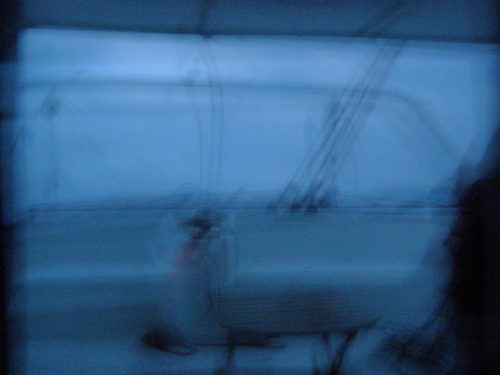 The waves seemed huge, and came at us from various angles; crashing over the top of the bimini, or barrelling in at us beam on. One particularly large wave hit us around 2 am on Wednesday night, and pushed the boat side-wards across the water. Synchronicity seemed to take an age to recover before she shook off the impact and bravely soldiered on. The wave pushed so much water that the sea went right through the hull portlight, saturating the navigation area and splashing the computer. Fortunately, the laptop wasn’t damaged and we then rigged a towel cover over the area to keep splashes away.
The waves seemed huge, and came at us from various angles; crashing over the top of the bimini, or barrelling in at us beam on. One particularly large wave hit us around 2 am on Wednesday night, and pushed the boat side-wards across the water. Synchronicity seemed to take an age to recover before she shook off the impact and bravely soldiered on. The wave pushed so much water that the sea went right through the hull portlight, saturating the navigation area and splashing the computer. Fortunately, the laptop wasn’t damaged and we then rigged a towel cover over the area to keep splashes away.
I started questioning my sanity. It was horrible. Everyone was sick to some degree. Holding a two-year-old while she whimpers and vomits is not fun. The eight-year-old and I had about three days without eating and continual trips to “spew corner”; the aft end of the leeward hull.
I felt so pathetic it took all my will power to get upright to meet my obligations in terms of watch keeping and parenting. I calculated how many first-class air tickets to luxury resorts we could enjoy with the proceeds from the boat. I was very concerned that this first family off-shore experience may be our last. I had to keep focusing on the tropical paradise.
One of the other boats in the fleet stopped at Raul Island in the Kermedecs. It’s not normally allowed without prior permission, but in rough conditions, the New Zealand government does allow boats to stop here for rest and emergency repairs. They were only two adults with young children so the opportunity to rest and avoid the worst of the conditions was significant.
As the weather deteriorated, the menu got pretty bland; or for the seasick crew, non-existent. Only one crew member managed to keep eating normally the whole trip. Snack food, treats, fruit, ready-made meals and pies were the stable fare. We tried “happy hour”, but the beverage was a can of lemonade with a few smiles.
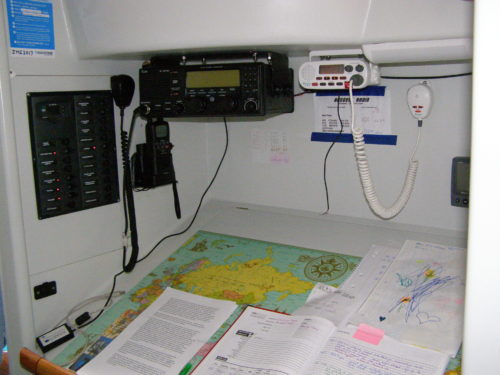 As part of the ICA rally, we maintained a daily sked with Des at Russell Radio which enabled friends and family to track our passage. Des provides a great safety service; recording positions, giving weather updates and handling message traffic.
As part of the ICA rally, we maintained a daily sked with Des at Russell Radio which enabled friends and family to track our passage. Des provides a great safety service; recording positions, giving weather updates and handling message traffic.
Navigation
In terms of navigation when we left Opua we entered only one waypoint, Tonga! We plotted our position on a paper chart once a day and record two-hourly position notes in the log, but mostly relied on the track shown on the Chartplotter. If anything had happened to the computer we could have reverted to the old fashioned way of recording GPS positions on the paper charts. We carried three GPS systems, an integrated GPS in the boats electronic instruments, and two hand-helds. We also had current paper charts for our planned route, destination and possible alternatives. If anything had happened to the GPS, we had aboard a sextant, an instruction book and some tables. We’d attended a short course on celestial navigation, but I would have hated to have to rely on it! Fortunately, we had no trouble with electronics.
Land ahoy
Day six. In the early hours the breeze started moderating and we hoisted the mainsail. Around mid-morning the storm jib came down and the big headsail was up. Hoorah, we were cruising along at ten knots. We started calculating our arrival time. The sun came out. Land appeared on the horizon almost exactly when expected.
But we weren’t there yet. There are two passages into Tongatapu’s lagoon. We could approach from the Piha Passage from the east or use the Egeria Channel, which connects to Ava Lahi Channel from the west. The latter was further away but we decided to use the Egeria Channel, as the sailing pilots all indicate Piha passage, a winding channel around large coral shoals, can be difficult.
As the afternoon wore on so did the tension. This was our first reef entry and we’d been warned electronic charts may not be accurate, and that buoys and beacons could be missing. We needed to get through while the sun was still high in the sky. The skipper was steering and searching for lead beacons, while the crew had the charts and hand bearing ready. I was working the computer software to plot positions, waypoints and gotos. Fortunately, our diligence paid off, the Egeria Channel was relatively straightforward.
Arrival
At 1752 on Friday 11th May we dropped anchor at Big Mamma’s Yacht Club, Pangaimotu. Other cruisers welcomed us with foghorns, clapping and the loud firing of a cannon. We were waving, I was crying, we were ecstatic. It was time to break out the bubbly and celebrate. We did.
We’d got through the reef just in time. By the time we were onto our second bottle of bubbly it was dark, but this was the most beautiful tropical paradise ever. It’s hopefully going to be a while before we have to endure an ocean passage again. At this stage I don’t even want to think about it.
Would I do it again? The destination is delightful, the opportunity to bond as a family unique, but ask me again in six months. The analogy another cruiser uses is childbirth, you develop selective memory, forget the bad bits and start to say “it wasn’t so bad”, next thing you know the cruising guides are out and you’re off again.
